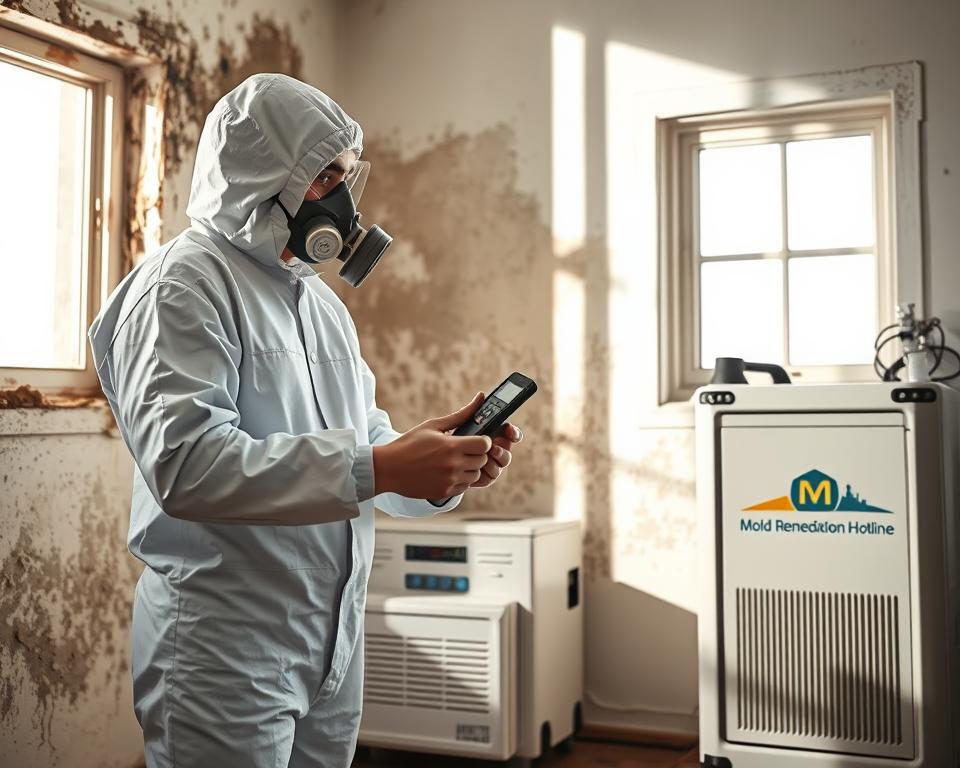Dark-colored growths thrive in damp spaces, spreading silently and releasing spores that threaten indoor air quality. These organisms multiply rapidly—some colonies expand from a speck to a visible patch in just 24 to 72 hours. Left unchecked, they compromise structural materials like drywall and carpet while posing risks to respiratory health.
Distinctive musty odors or discolored patches on walls often signal an urgent problem. DIY solutions rarely address hidden moisture sources, allowing regrowth. Certified experts use advanced containment methods to prevent cross-contamination during cleanup. For example, SERVPRO’s teams deploy HEPA filtration and antimicrobial treatments to restore safety.
Immediate action matters. Emergency responders are available 24/7 to halt infestations before they escalate. Their process includes identifying water leaks, isolating affected areas, and using industrial-grade equipment to eliminate colonies at the root.
Key Takeaways
- Rapid growth can occur within one to three days after moisture exposure.
- Specialized techniques prevent spores from spreading during cleanup.
- Round-the-clock emergency response minimizes long-term damage.
- Complete remediation requires fixing hidden water issues.
- Professional-grade tools ensure thorough elimination and air quality restoration.
Understanding the Mold Problem and Health Risks
The Environmental Protection Agency states:
“When excessive moisture accumulates in buildings or on building materials, mold growth often occurs.”
This persistent issue starts small but escalates quickly when water intrusion or humidity goes unchecked. Below we examine key causes and consequences every property owner should recognize.
Common Mold Growth Triggers
Moisture acts as the primary catalyst for fungal development. Leaky roofs, burst pipes, or flooded basements create immediate breeding grounds. Even everyday activities like showering or cooking raise indoor humidity above 60%—a critical threshold for spore activation.
| Trigger | Common Sources | Time to Growth |
|---|---|---|
| Water Intrusion | Roof leaks, plumbing failures | 24-48 hours |
| High Humidity | Poor ventilation, HVAC issues | 1-2 weeks |
| Stagnant Air | Closed basements, cramped attics | 3-5 days |
Potential Health Hazards from Mold Exposure
Breathing difficulties and allergic reactions rank among the most frequent complaints. Those with asthma or weakened immune systems face heightened risks—spores can trigger severe attacks or long-term respiratory complications.
- Persistent coughing or wheezing
- Skin rashes or eye irritation
- Chronic sinus congestion
Early detection and professional assessment prevent minor issues from becoming major health threats. Technicians use moisture meters and infrared cameras to locate hidden problem areas before they escalate.
The Mold Remediation Process
When fungal colonies invade properties, certified teams follow precise protocols to restore safety. This structured approach combines scientific analysis with industrial-grade solutions to address both visible and hidden threats.
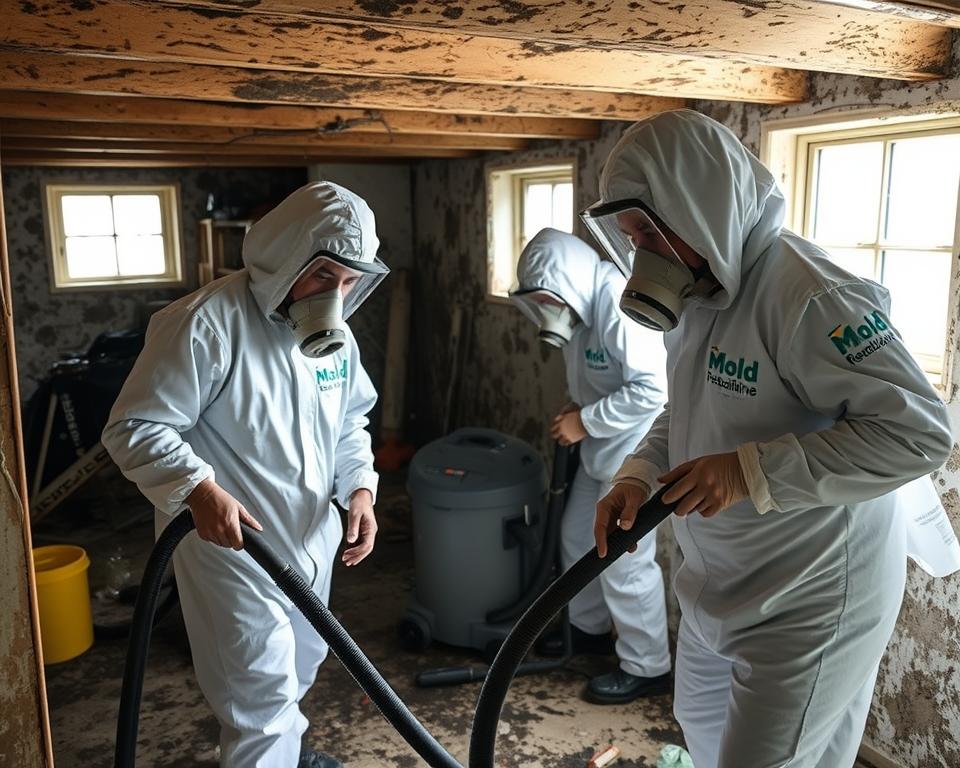
Mold Inspection and Damage Assessment
Technicians begin by scanning every corner using infrared cameras and moisture meters. These tools detect temperature variations and hidden dampness behind walls—common hotspots for silent growth. Air sampling tests identify spore types and concentrations, creating a roadmap for targeted treatment.
SERVPRO emphasizes:
“Documenting contamination levels ensures no compromised area goes untreated.”
This phase also pinpoints water sources like pipe leaks or foundation cracks that fuel biological growth.
Containment and Air Filtration Measures
Before cleanup starts, plastic barriers seal off affected zones. Negative air pressure machines prevent spore migration, acting like invisible shields around work areas. Industrial air scrubbers with HEPA filters run continuously, trapping 99.97% of particles as small as 0.3 microns.
Key steps include:
- Shutting down HVAC systems to avoid spreading contaminants
- Using antimicrobial sprays on adjacent surfaces
- Bagging debris in sealed containers for safe disposal
This multilayered strategy protects both workers and untouched spaces during the restoration phase.
Health-Safe Black Mold Removal Services
Certified professionals combine cutting-edge methods with rigorous safety standards to tackle hazardous fungal infestations. Their approach eliminates visible colonies while preventing spore dispersion—critical for protecting vulnerable occupants during remediation.
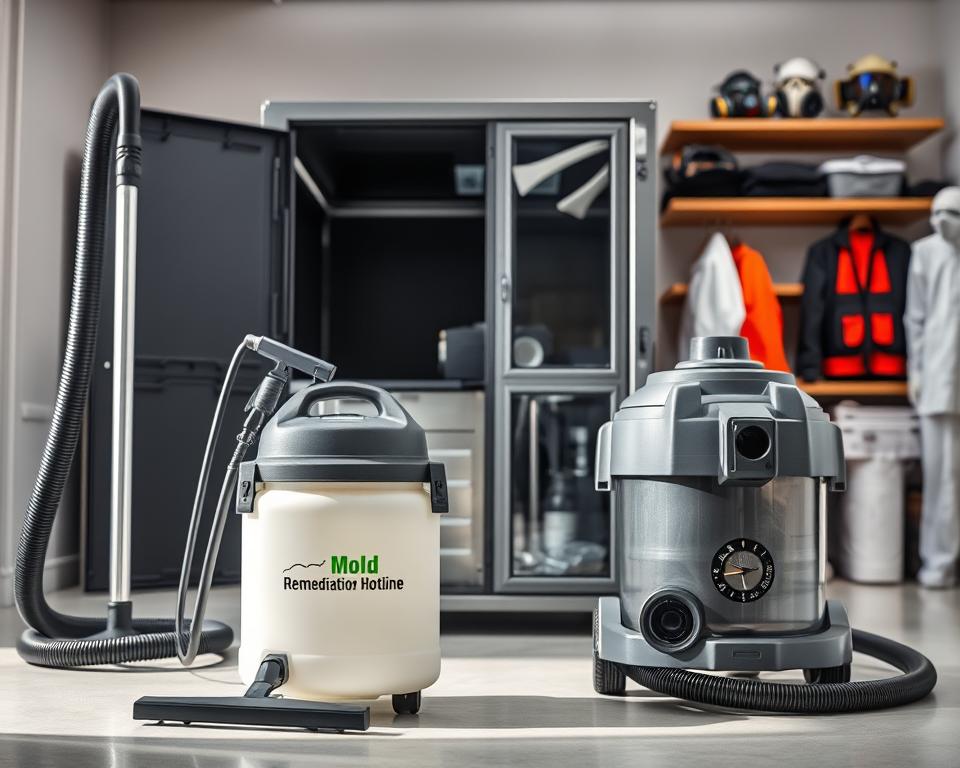
Specialized Techniques and Equipment
Advanced protocols go beyond surface cleaning. Teams use controlled demolition to remove compromised materials without releasing particles. Antimicrobial foggers penetrate porous surfaces, neutralizing colonies at their roots.
Industrial-grade tools like HEPA air scrubbers cycle contaminated air 4–6 times hourly. Negative pressure chambers contain work areas, while infrared cameras detect hidden moisture sources. This multi-layered strategy addresses both current growth and future risks.
Licensed and Experienced Technicians
IICRC-certified crews undergo annual training on evolving fungal threats. SERVPRO team members follow strict guidelines:
“Our technicians document every step—from PPE protocols to waste disposal—ensuring accountability.”
They assess structural vulnerabilities during cleanup, advising clients on preventive measures. Continuous air monitoring confirms spore levels return to safe thresholds before project completion.
| Aspect | DIY Approach | Professional Solution |
|---|---|---|
| Containment | Plastic sheeting | Sealed negative-air zones |
| Air Quality | Open windows | HEPA filtration systems |
| Disinfection | Bleach solutions | EPA-registered antimicrobials |
Addressing Mold Issues in Your Home and Business
Unchecked moisture creates hidden dangers in both residential and commercial spaces. Swift action prevents structural harm and protects occupants from respiratory concerns. Specialists use strategic methods to contain growth while minimizing disruption to daily life.
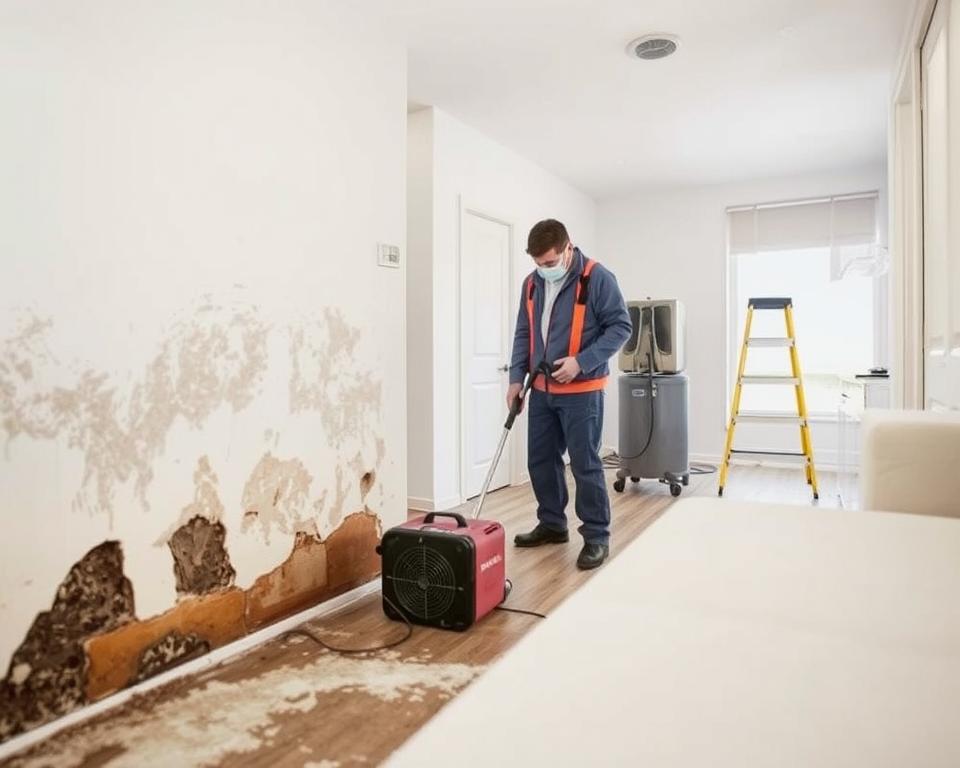
Determining the Source of Moisture
Finding water entry points stops fungal growth at its roots. Professionals inspect properties using thermal imaging and hygrometers. These tools detect leaks behind walls or under floors that homeowners might miss.
Common trouble spots include:
- Cracked pipes under sinks
- Clogged roof gutters
- Condensation around AC units
| Location | Residential Risks | Commercial Risks |
|---|---|---|
| Bathrooms | Shower leaks | Faulty plumbing in multi-stall restrooms |
| Basements | Foundation seepage | Storage area flooding |
| HVAC Systems | Dirty filters | Ductwork contamination |
Preventing Mold Spread to Other Areas
Containment barriers and negative air pressure keep spores from migrating. SERVPRO teams often work after hours in businesses to avoid operational downtime. Their process includes:
- Sealing doorways with plastic sheeting
- Running industrial air scrubbers
- Disposing contaminated materials offsite
Regular moisture checks help properties stay dry long after cleanup. Combining professional expertise with preventive measures creates safer environments for families and employees alike.
Effective Cleaning and Restoration Methods
Professional teams deploy science-backed strategies to eliminate fungal threats while restoring properties to pre-damage conditions. Their approach balances aggressive treatment of affected areas with meticulous reconstruction of compromised spaces.
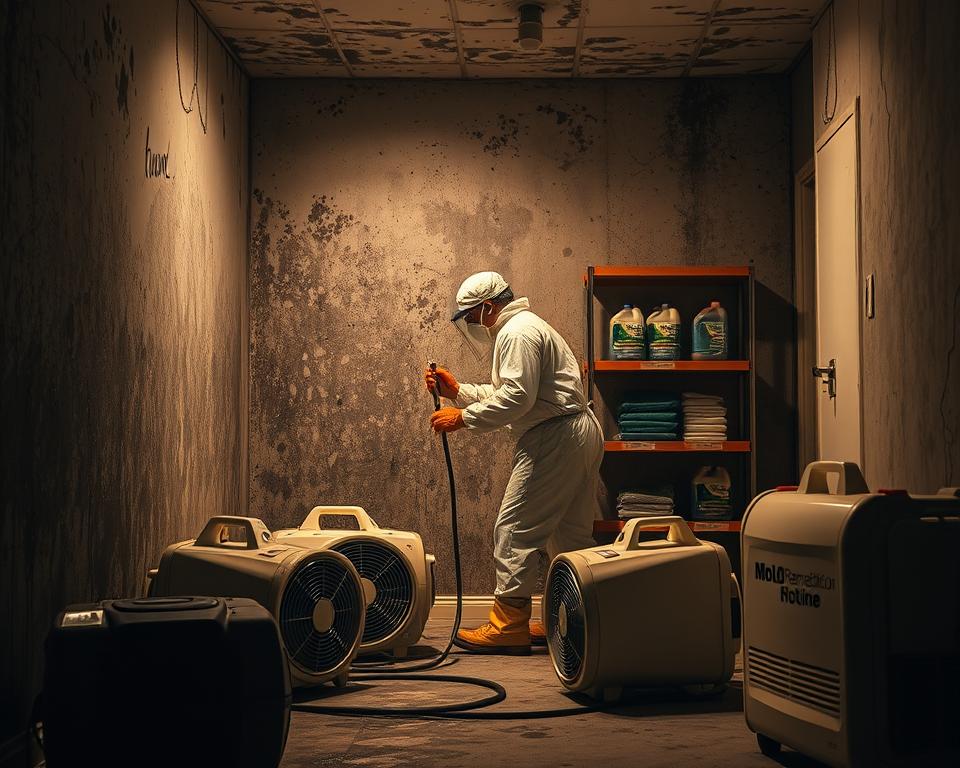
Antifungal and Antimicrobial Treatments
Specialized solutions penetrate deep into porous surfaces like wood and concrete. SERVPRO technicians apply EPA-registered agents that destroy existing colonies and create protective barriers. One expert notes:
“Our treatments target root networks invisible to the naked eye, stopping regrowth at the source.”
Key applications include:
- Fogging hard-to-reach HVAC ducts and crawl spaces
- Injecting antimicrobial foam into wall cavities
- Treating subflooring with long-lasting preventive coatings
Restoration and Repair Procedures
After eliminating contamination, crews assess structural integrity using moisture meters and infrared scanners. Irreparable materials like soaked insulation get removed under containment protocols. Replacement materials often feature mold-resistant properties:
| Material Removed | Replacement Product | Protection Benefit |
|---|---|---|
| Standard drywall | Paperless gypsum board | Water-resistant core |
| Fiberglass insulation | Closed-cell spray foam | Moisture barrier |
| Plywood subfloor | Concrete backer board | Fungal growth prevention |
Final steps include air quality testing and applying protective sealants to vulnerable areas. This comprehensive process ensures spaces remain safe and functional for years.
Moisture Management and Prevention of Mold Growth
Effective environmental control stops fungal issues before they start. Managing humidity and airflow creates conditions where biological growth struggles to establish. SERVPRO professionals advise immediately turning off HVAC systems during inspections to prevent mold spores from spreading through vents.
Controlling Indoor Humidity
Keeping indoor moisture below 60% stops the dampness that lets mold grow. Dehumidifiers and ventilation systems work together to pull excess water from bathrooms and basements. Regular checks for leaks eliminate hidden water sources that fuel fungal growth.
Improving Indoor Air Quality
Advanced filtration systems capture particles before they settle. HEPA filters trap 99.97% of contaminants, while UV lights neutralize microorganisms. Properly sealed windows and exhaust fans ensure spores can’t thrive in stale air.
Experts recommend moisture sensors and drainage upgrades for lasting protection. These strategies control moisture effectively while maintaining healthy indoor air quality and preventing costly damage.
